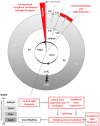The Development and Decay of the Circadian Clock in Drosophila melanogaster
- PMID: 33089181
- PMCID: PMC7445846
- DOI: 10.3390/clockssleep1040037
The Development and Decay of the Circadian Clock in Drosophila melanogaster
Abstract
The way in which the circadian clock mechanism develops and decays throughout life is interesting for a number of reasons and may give us insight into the process of aging itself. The Drosophila model has been proven invaluable for the study of the circadian clock and development and aging. Here we review the evidence for how the Drosophila clock develops and changes throughout life, and present a new conceptual model based on the results of our recent work. Firefly luciferase lines faithfully report the output of known clock genes at the central clock level in the brain and peripherally throughout the whole body. Our results show that the clock is functioning in embryogenesis far earlier than previously thought. This central clock in the fly remains robust throughout the life of the animal and only degrades immediately prior to death. However, at the peripheral (non-central oscillator level) the clock shows weakened output as the animal ages, suggesting the possibility of the breakdown in the cohesion of the circadian network.
Keywords: aging; central and peripheral clocks; clock gene reporter.
© 2019 by the authors.
Conflict of interest statement
Conflicts of InterestThe authors declare no conflict of interest.
Figures


Similar articles
-
Development of the Molecular Circadian Clock and Its Light Sensitivity in Drosophila Melanogaster.J Biol Rhythms. 2019 Jun;34(3):272-282. doi: 10.1177/0748730419836818. Epub 2019 Mar 18. J Biol Rhythms. 2019. PMID: 30879378
-
Clock gene expression and locomotor activity predict death in the last days of life in Drosophila melanogaster.Sci Rep. 2018 Aug 9;8(1):11923. doi: 10.1038/s41598-018-30323-x. Sci Rep. 2018. PMID: 30093652 Free PMC article.
-
The functional changes of the circadian system organization in aging.Ageing Res Rev. 2019 Jul;52:64-71. doi: 10.1016/j.arr.2019.04.006. Epub 2019 Apr 29. Ageing Res Rev. 2019. PMID: 31048031 Review.
-
A Robust and Self-Sustained Peripheral Circadian Oscillator Reveals Differences in Temperature Compensation Properties with Central Brain Clocks.iScience. 2020 Aug 21;23(8):101388. doi: 10.1016/j.isci.2020.101388. Epub 2020 Jul 20. iScience. 2020. PMID: 32798967 Free PMC article.
-
Techniques that revealed the network of the circadian clock of Drosophila.Methods Enzymol. 2005;393:439-51. doi: 10.1016/S0076-6879(05)93021-8. Methods Enzymol. 2005. PMID: 15817304 Review.
Cited by
-
Circadian clock-independent ultradian rhythms in lipid metabolism in the Drosophila fat body.J Biol Chem. 2025 Jun;301(6):110245. doi: 10.1016/j.jbc.2025.110245. Epub 2025 May 16. J Biol Chem. 2025. PMID: 40383146 Free PMC article.
References
-
- The 2017 Nobel Prize in Physiology or Medicine—Press Release. [(accessed on 9 October 2019)]; Available online: https://www.nobelprize.org/prizes/medicine/2017/press-release/
-
- Brett W.J. Persistent Diurnal Rhythmicity in Drosophila Emergence1. Ann. Entomol. Soc. Am. 1955;48:119–131. doi: 10.1093/aesa/48.3.119. - DOI
Publication types
LinkOut - more resources
Full Text Sources
Molecular Biology Databases

